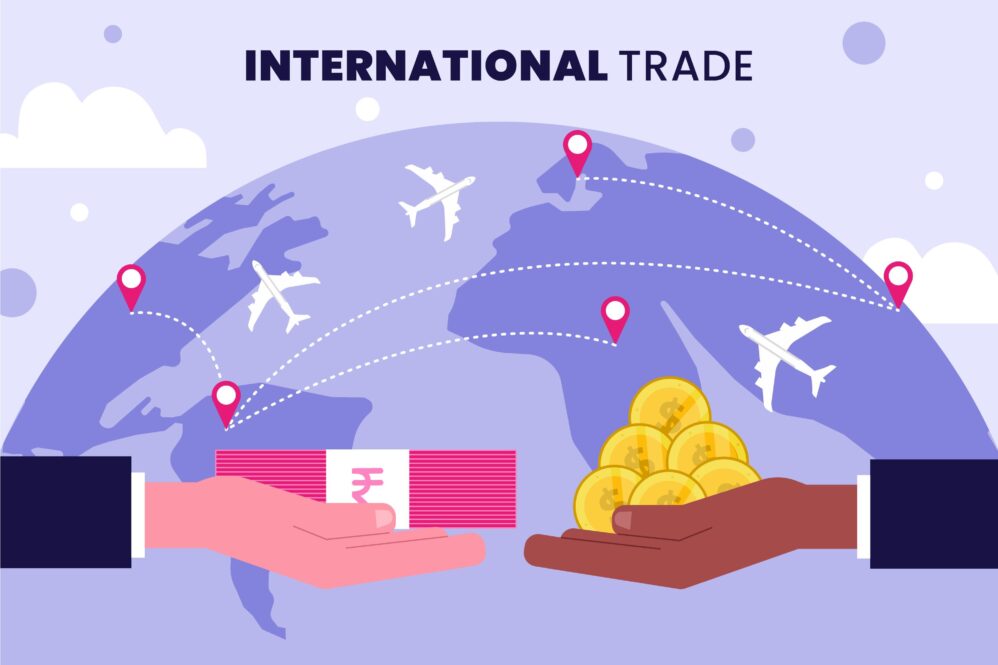International trade agreements play a vital role in shaping the global business landscape. These agreements, often negotiated between countries or groups of countries, establish a framework for the exchange of goods, services, and investments across borders. By reducing trade barriers, promoting fair competition, and establishing a predictable business environment, these agreements can have a significant impact on businesses of all sizes.
In this blog post, we will explore the topic of international trade agreements and delve into how they can benefit your business. We will discuss the various types of trade agreements, their objectives, and the advantages they offer to businesses operating in today’s interconnected world.
The global economy has become increasingly integrated, with businesses seeking opportunities beyond their domestic markets. International trade agreements provide a foundation for expanding market access, enhancing export opportunities, and fostering economic growth. They aim to create a level playing field by addressing trade barriers such as tariffs, quotas, and regulatory obstacles, enabling businesses to compete more effectively on a global scale.
Understanding the intricacies of trade agreements is crucial for businesses looking to capitalise on their benefits. Whether you are a small startup or a multinational corporation, navigating the complexities of international trade can be challenging. However, by familiarising yourself with trade agreements and their potential advantages, you can position your business for success in the global marketplace.
Understanding International Trade Agreements
A. Definition and types of trade agreements
International trade agreements are legally binding agreements between two or more countries that govern and regulate trade-related activities. These agreements are designed to promote economic cooperation, facilitate trade flows, and create a stable and predictable environment for businesses operating across borders.
There are various types of trade agreements, each serving different purposes and covering different aspects of trade. Some common types include:
1. Free Trade Agreements (FTAs):
These agreements eliminate or significantly reduce trade barriers, such as tariffs and quotas, between participating countries. FTAs aim to promote the liberalisation of trade and foster closer economic integration among member nations. Examples of prominent FTAs include the North American Free Trade Agreement (NAFTA) and the Comprehensive and Progressive Agreement for Trans-Pacific Partnership (CPTPP).
2. Customs Unions:
Customs unions go beyond the elimination of tariffs and quotas and also establish a common external tariff for non-member countries. This means that member countries adopt a unified approach to trade with non-members, fostering a deeper level of integration. The European Union (EU) is an example of a customs union.
3. Regional Trade Agreements (RTAs):
RTAs are trade agreements among countries within a specific region. These agreements aim to enhance economic cooperation, increase market access, and promote regional integration. Examples include the Association of Southeast Asian Nations (ASEAN) and the Southern Common Market (MERCOSUR).
B. Key principles and objectives of trade agreements
Trade agreements are based on several key principles and objectives that guide their development and implementation. These principles include:
1. Most-Favoured-Nation (MFN) Treatment:
MFN treatment ensures that each member country extends the same favourable trade terms to all other member countries. It promotes non-discrimination and equal treatment in trade relations, preventing preferential treatment to specific countries.
2. National Treatment:
National treatment requires member countries to treat foreign goods, services, and investors no less favourably than their domestic counterparts once they have entered their markets. This principle helps create a level playing field and reduces discriminatory practices.
3. Market Access:
Trade agreements aim to improve market access by reducing or eliminating trade barriers, such as tariffs, quotas, and non-tariff measures. By opening up markets, businesses can reach a larger customer base and explore new opportunities.
4. Rules-Based System:
Trade agreements establish a rules-based system that provides clarity, transparency, and predictability for businesses. These rules cover areas such as customs procedures, intellectual property rights, investment protection, and dispute settlement mechanisms.
C. Examples of prominent international trade agreements
Numerous international trade agreements exist today, shaping global trade patterns and providing opportunities for businesses worldwide. Let’s look at a few prominent examples:
1. World Trade Organization (WTO):
The WTO is a global organisation that oversees international trade and provides a forum for negotiating trade agreements. It sets rules and regulations for trade among its member countries and aims to promote free and fair trade on a global scale.
2. United States-Mexico-Canada Agreement (USMCA):
The USMCA replaced NAFTA and governs trade between the United States, Canada, and Mexico. It includes provisions related to market access, intellectual property protection, labour rights, and environmental standards.
3. European Union (EU):
The EU is an economic and political union comprising 27 member countries in Europe. It has established a single market with free movement of goods, services, capital, and labour among member states. The EU also negotiates trade agreements on behalf of its member countries.
Understanding these trade agreements and their objectives is crucial for businesses seeking to benefit from international trade.
Economic Benefits of International Trade Agreements
International trade agreements offer a wide range of economic benefits for businesses. By reducing trade barriers and creating favourable conditions for cross-border trade, these agreements can significantly impact the growth and profitability of companies. Let’s explore some of the key economic benefits:
A. Market access and increased customer base
1. Removal of trade barriers:
Trade agreements often aim to eliminate or reduce tariffs, quotas, and other trade barriers. This increased market access allows businesses to reach a larger customer base in foreign markets. It opens up opportunities to sell products or services to customers who were previously inaccessible due to high import duties or restrictions.
2. Tariff reduction or elimination:
Trade agreements frequently involve tariff concessions, lowering the cost of imported inputs or finished goods. This reduction in tariffs can make products more affordable for consumers, stimulate demand, and create a competitive advantage for businesses operating within the agreement.
B. Enhanced export opportunities
1. Access to new markets:
Trade agreements provide businesses with access to new markets that were previously difficult to penetrate. By reducing trade barriers and harmonising regulations, these agreements create a more favourable environment for exporting goods and services. Businesses can explore untapped markets, expand their customer base, and diversify their revenue streams.
2. Increased demand for products/services:
Trade agreements often lead to increased demand for goods and services as trade barriers diminish. This surge in demand can benefit businesses, particularly those with a competitive advantage in specific sectors or industries. Export-oriented businesses can experience heightened sales and revenue, driving overall growth and expansion.
C. Competitive advantage and business growth
1. Lower production costs:
International trade agreements can reduce the cost of production by enabling businesses to access cheaper inputs and resources from other member countries. This cost advantage can enhance competitiveness and profitability, allowing businesses to offer products or services at more competitive prices.
2. Access to cheaper inputs and resources:
Trade agreements promote trade in goods, services, and investments. As a result, businesses can source inputs and resources from countries with a comparative advantage in producing them at a lower cost. This access to cost-effective inputs can optimise production processes and contribute to overall cost savings.
3. Expansion of production scale:
With increased market access and export opportunities, businesses can expand their production scale to meet rising demand. Trade agreements often create a more stable and predictable business environment, providing the confidence and incentives necessary for businesses to invest in expanding their operations.
These economic benefits demonstrate the potential for trade agreements to drive business growth, boost competitiveness, and unlock new opportunities for companies of all sizes. However, it’s important to recognize that the advantages can vary depending on the specific industry, market conditions, and the ability of businesses to adapt to changing trade dynamics.
Non-Economic Benefits of International Trade Agreements

International trade agreements offer not only economic advantages but also a range of non-economic benefits that can significantly impact businesses. These benefits go beyond market access and trade facilitation, providing a supportive framework for business operations. Let’s delve into the non-economic benefits of trade agreements:
A. Legal Framework and dispute resolution mechanisms
1. Protection of intellectual property rights:
Trade agreements often include provisions for the protection of intellectual property rights. This safeguards businesses’ inventions, trademarks, copyrights, and trade secrets, enabling them to innovate and compete on a global scale. Clear rules and enforcement mechanisms help businesses safeguard their intellectual property assets.
2. Dispute settlement procedures:
Trade agreements establish mechanisms for resolving disputes between member countries. These procedures provide businesses with a reliable framework for addressing trade-related conflicts, ensuring fair and equitable resolution. Having a robust dispute settlement system reduces uncertainty and promotes confidence in international trade transactions.
B. Regulatory harmonisation and standards
1. Alignment of regulations and standards:
Trade agreements often encourage regulatory harmonisation among member countries. This alignment of regulations and standards simplifies compliance requirements for businesses operating in multiple markets. It reduces duplication of efforts, streamlines processes, and enhances efficiency in areas such as product safety, labelling, and technical specifications.
2. Reduction of compliance costs:
Harmonisation of regulations can result in cost savings for businesses. By adhering to unified standards, businesses can avoid the need for multiple product variations or costly compliance procedures. This reduces administrative burdens, enhances competitiveness, and improves access to diverse markets.
C. Collaboration and knowledge sharing
1. Opportunities for technology transfer:
International trade agreements can facilitate technology transfer between member countries. This exchange of knowledge and technology can benefit businesses by enhancing their technological capabilities, improving productivity, and fostering innovation. Access to new technologies can provide a competitive edge and drive business growth.
2. Exchange of best practices and innovation:
Trade agreements create platforms for member countries to share best practices and learn from one another. Businesses can gain insights into innovative approaches, strategies, and processes that can optimise their operations. This collaborative environment fosters learning, drives innovation, and contributes to continuous improvement.
By promoting legal protection, facilitating regulatory harmonisation, and fostering collaboration, trade agreements create an enabling environment for businesses to thrive. These non-economic benefits enhance the overall competitiveness, stability, and sustainability of businesses operating in the global marketplace.
Potential Challenges and Considerations
While international trade agreements offer numerous benefits for businesses, it is important to recognize that they also come with potential challenges and considerations. Understanding and mitigating these challenges is crucial for businesses seeking to maximise the advantages of trade agreements. Let’s explore some of the key considerations:
A. Potential Risks and Downsides of trade agreements
1. Market volatility and uncertainty:
Trade agreements can be subject to geo-political dynamics and changing political landscapes. Shifts in government policies, trade tensions, or the withdrawal of countries from agreements can introduce uncertainty and disrupt business operations. Businesses need to stay informed and adaptable to mitigate potential risks.
2. Unequal distribution of benefits:
Trade agreements may not benefit all businesses or sectors equally. Some industries may face increased competition from foreign companies, while others may struggle to adapt to new market conditions. Businesses should carefully assess the potential impact of trade agreements on their specific industry and develop strategies to remain competitive.
B. Impact on Domestic Industries and Employment
1. Displacement of domestic industries:
In some cases, trade agreements can lead to the displacement or decline of domestic industries that cannot compete with cheaper imports. Businesses and governments need to anticipate and address any negative consequences, such as job losses or economic disparities, through targeted support programs or industry diversification initiatives.
2. Adjustment and retraining requirements:
Trade agreements can require businesses to adapt their operations, products, or services to meet international standards or changing market demands. This may necessitate investments in technology, skills development, or retraining of employees to ensure competitiveness in the global marketplace.
C. Compliance with complex rules and regulations
1. Compliance costs and administrative burdens:
Trade agreements often come with complex rules of origin, documentation requirements, and compliance procedures. Meeting these requirements can entail additional costs and administrative burdens for businesses, particularly small and medium-sized enterprises (SMEs). Businesses need to allocate resources and ensure they have the capacity to comply with the regulatory obligations imposed by trade agreements.
2. Understanding and navigating rules of origin:
Rules of origin determine the eligibility of products for preferential treatment under trade agreements. Complying with rules of origin can be complex, involving detailed analysis of product components, manufacturing processes, and documentation. Businesses should invest in understanding and correctly applying rules of origin to maximise the benefits of trade agreements.
D. Geopolitical and trade tensions
1. Changing geopolitical dynamics:
Geopolitical events, trade disputes, or political tensions between countries can impact the stability and predictability of trade agreements. Businesses need to monitor geopolitical developments and assess the potential impact on their operations, supply chains, and market access.
2. Evolving trade policies:
Trade policies can change over time as governments reassess their priorities and negotiate new agreements. Businesses should stay informed about trade policy developments and anticipate potential changes that may affect their operations or market opportunities.
By recognizing these potential challenges and considerations, businesses can develop strategies to navigate the complexities of trade agreements effectively. Adapting to changing trade dynamics, investing in resilience, and staying informed will be key to maximising the benefits of international trade agreements.
Strategies for Maximising the Benefits of Trade Agreements
To fully capitalise on the advantages offered by international trade agreements, businesses need to develop effective strategies that align with the evolving global trade landscape. Here are some practical strategies and recommendations for maximising the benefits of trade agreements:
A. Conducting market research and analysis
1. Identify target markets:
Research and identify potential markets that offer growth opportunities for your products or services. Consider factors such as market size, consumer preferences, and the competitive landscape within the countries covered by the trade agreement.
2. Understand market dynamics:
Gain insights into market trends, cultural nuances, and regulatory frameworks of the target markets. This understanding will help you tailor your products, marketing strategies, and business operations to meet the specific needs and expectations of customers in those markets.
B. Developing export strategies
1. Assess export readiness:
Evaluate your company’s capabilities, resources, and readiness to enter international markets. Consider factors such as production capacity, quality control, distribution channels, and export financing options. Identify areas that may require improvement or investment to ensure a smooth entry into new markets.
2. Build relationships with partners:
Establish partnerships with local distributors, agents, or representatives who know the target markets. These partnerships can provide valuable insights, facilitate market entry, and help navigate local regulations and customs.
C. Building partnerships and networks
1. Participate in trade fairs and exhibitions:
Trade fairs and exhibitions offer valuable networking opportunities and a platform to showcase your products or services to potential buyers and partners. Engage in these events within the target markets to establish connections and expand your business network.
2. Join industry associations and chambers of commerce:
Industry associations and chambers of commerce provide access to industry-specific information, networking events, and advocacy platforms. By becoming a member, you can tap into valuable resources, stay updated on industry trends, and connect with like-minded businesses.
D. Staying updated with trade agreement developments
1. Monitor trade policy changes:
Stay informed about any updates or revisions to existing trade agreements or the negotiation of new ones. Regularly follow news, industry publications, and official government sources to understand the potential impact of these changes on your business operations and market opportunities.
2. Engage in policy advocacy:
Actively engage with industry associations, chambers of commerce, and other business networks to advocate for your business interests in trade policy discussions. Provide feedback, share insights, and contribute to policy dialogues to ensure your perspectives are considered during trade agreement negotiations.
By implementing these strategies, businesses can position themselves to maximise the benefits of international trade agreements. However, it is essential to remain adaptable and agile in response to evolving trade dynamics and market conditions. Continuous evaluation, learning, and adjustment of strategies will be key to sustained success in the global marketplace.
In the concluding section of this blog post, we will recap the benefits of international trade agreements for businesses and emphasise the importance of understanding and leveraging these agreements to drive growth and success.
Conclusion
International trade agreements hold immense potential for businesses seeking to expand their operations, access new markets, and achieve sustainable growth. Throughout this blog post, we have explored the various aspects of trade agreements and how they can benefit businesses. From economic advantages such as market access and export opportunities to non-economic benefits like legal protection and regulatory harmonisation, these agreements offer a range of opportunities for businesses of all sizes and sectors.
However, it is important to approach trade agreements with a strategic mindset and a keen understanding of the complexities involved. Businesses must navigate potential challenges such as market volatility, compliance costs, and geopolitical dynamics. By implementing the following strategies, businesses can maximise the advantages of trade agreements:
– Conducting thorough market research and analysis to identify target markets and understand their dynamics.
– Developing export strategies that align with market requirements and leverage local partnerships.
– Building partnerships and networks through trade fairs, industry associations, and chambers of commerce.
– Staying updated with trade agreement developments and engaging in policy advocacy.
Businesses must remain adaptable and agile in response to changing trade dynamics. Regularly assess your strategies, monitor market conditions, and make necessary adjustments to ensure your business remains competitive and resilient.
As we look to the future, international trade agreements will continue to shape the global business landscape. Stay informed, embrace innovation, and seize the opportunities presented by these agreements. By understanding and leveraging trade agreements, businesses can unlock new horizons, drive growth, and position themselves for success in the interconnected world of international trade.
Remember, each business is unique, and the benefits of trade agreements will vary depending on your industry, market, and individual circumstances. By evaluating your business needs and aligning your strategies with the opportunities presented by trade agreements, you can harness their potential to benefit your business in the long term.
Embrace the possibilities that international trade agreements offer, explore new markets, and embark on a journey of growth and prosperity in the global marketplace. The world is waiting for your business to thrive, and trade agreements can be the catalyst that propels you toward greater success.












